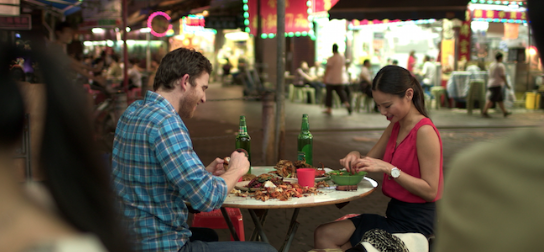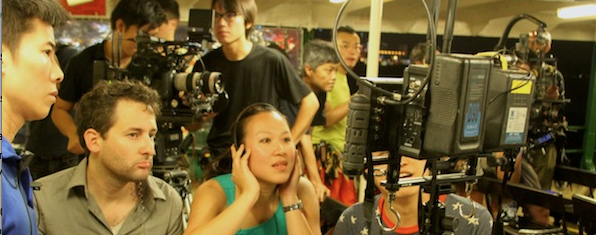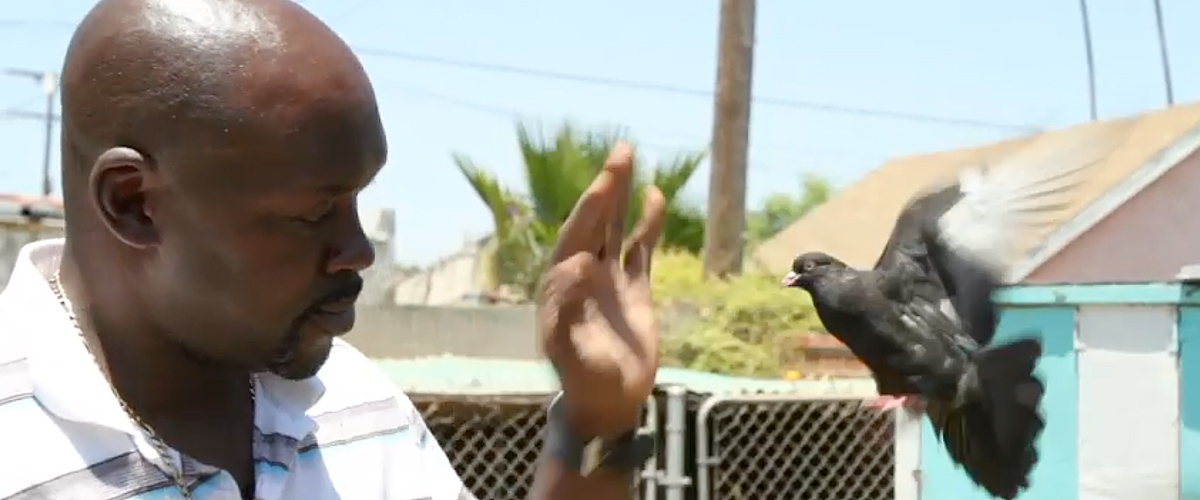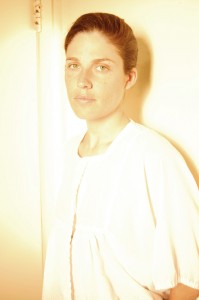Film Independent is now accepting submissions until August 4, 2014 for our quarterly 2014 Canon Filmmaker Award. Four times a year, we select one filmmaker to receive a Canon Cinema EOS package loaned to the recipient. Only Film Independent Fellows, Los Angeles Film Festival alumni and Spirit Awards nominees and winners are eligible. Click here for complete eligibility details and to apply. Last quarter’s winner was filmmaker Emily Ting with her feature debut It’s Already Tomorrow in Hong Kong. Emily has put the pedal to the metal recently and it’s quite astonishing what she has accomplished. She is currently in post-production on the film A Year and Change which she produced just after taking the project through the Film Independent Producing Lab last fall. She executive produced Man From Reno and co-executive produced Land Ho!, both of which played the 2014 Los Angeles Film Festival. And she wrote and directed It’s Already Tomorrow in Hong Kong–in Hong Kong. I caught up with Emily to hear about the making of and what she learned on the shoot. Tell us about the film and why is it important to you to tell this story? It’s Already Tomorrow in Hong Kong is a walk and talk romance in the tradition of Before Sunrise set in Hong Kong. Ruby is a Chinese American toy designer visiting Hong Kong for the first time for work, and Josh is an American expat working in finance who’s lived in Hong Kong for over 10 years. They meet while Ruby is looking for directions to Lan Kwai Fong and Josh shows her the way. An attraction forms between them, but timing may not quite be on their side. Anyone who knows me knows that I am obsessed with the Before Sunrise trilogy. Shortly after college, I lived in Hong Kong for five years as an expat, and for years I’ve said that someone needs to make a walk and talk romance set in this gorgeous city. And since no one ever did, I decided to make exactly that as my directorial debut. This movie, more than being a homage to my favorite film of all time, is also a love letter to a city that was so instrumental in shaping much of my adult life. And… I may or may not have met a cute expat in Hong Kong once. How did the shoot go? What were your biggest challenges with making this film? We shot for 14 days in Hong Kong and despite all the challenges going in, the shoot went really smoothly! There are so many challenges with making your first film in a foreign country. The biggest being not knowing anyone there who is willing to do you any favors or have a support system you can lean on. I felt really lost and helpless until I met my wonderful producer Sophia Shek. She really made the whole film happen and opened up her support system to me and called on favors on my behalf. Once Sophia was able to put together a local crew for me and take care of locking down locations and securing the necessary permits, the biggest challenge became dealing with the fickle Hong Kong weather. It rains almost every day and always at the most random times. But we got so lucky with the rain! Miraculously, it would always rain right before we rolled camera or start right when we’re wrapping. We did get rained out a couple of times but it was always after we’ve gotten everything we needed and the crew was happy to break anyway. Besides the rain, we’re also dealing with 100% humidity and shooting exterior nights every single day. And since much of the Hong Kong skyline and neon signs shuts off at midnight, we could only shoot for 6 hours on many nights. So we were always running and gunning. And we also had to pay off the local triad in order to shoot in certain locations we wanted, which is something I’ve never dealt with before.
Who is on your creative team and how did you all come to work together? Bryan Greenberg and Jamie Chung play the two star-crossed lovers and they’re also a real-life couple. As a producer I had done a couple of movies with Bryan and I’ve always had Jamie in mind for the role of Ruby. Some time after Bryan wrapped on the first movie we worked on together, they started dating. At the premiere party, I told Bryan about the Hong Kong film and asked him to pass the script along to Jamie. They read it out loud to each other two weeks later, and said they were in. I am so incredibly lucky to have them on board this film. The chemistry that comes with being a real life couple just can’t be engineered. The DP Josh Silfen and I first met at NYU Film School and have been friends for over a decade. We’ve worked together a lot as producer and DP and he has also shot some shorts and commercials I’ve directed. Even though Josh is my go-to DP, I wasn’t sure if he was necessarily the best person for this job because he’s never even been to Hong Kong before, let alone shot there. So last year, we flew out to Hong Kong for a camera test and based on his passion for the material and understanding of my visual sensibilities, it just became a no-brainer to have him on board. Long before I even had a producer, he was my first collaborator on this project at a time when I had none. And being a first-time director, it was really important for me to not only have a really experienced DP standing next to me at the monitor guiding me through it all, but also a friend who could be my moral support. Tell us a bit about the development process and your preparation as a director? Once the actors signed on, I worked really closely with them on perfecting the script. We would get together and read through the script and just tackle any issues they had with dialogue or character motivation. They also flew out to Hong Kong early so that we could have a week of rehearsals where we further broke down the script and discovered the beats before we rolled camera. On the visual side, Josh and I watched a lot of different films together that had a similar sensibility to this film and came up with a visual style together. And then we shot-listed the whole film together. We would shot list again every time I discovered a new location I’d rather shoot in, which happened quite often. And then we would go over the shots every day before call time once we got to Hong Kong. I don’t think Josh wants to see another shot list for a while after this movie. What is the visual look and feel you are trying to achieve with this film and why did you want to shoot with the Canon Cinema EOS? We wanted to go with a very raw and naturalistic look for the film. We wanted the camerawork (which is mostly handheld) to be non-obtrusive–to stay out of the way of the performers as much as possible and just let their chemistry shine through. We wanted to capture the rich textures and colors of Hong Kong as well as use as much of the city’s natural ambiance (the skyline, the neon lights) as the lighting source as possible. We needed a camera that can perform very well under low light conditions and we knew that the Canon C300 could because we came to Hong Kong last year and actually tested this camera. We ended up shooting on the C500 and we couldn’t be more pleased with the results. Visually, I think we really did Hong Kong justice in this film. I still can’t get over how beautiful everything looks! How have you built the support for this film and how are you putting together your financing? We are very lucky to have been so warmly embraced by the Hong Kong community. We started out a little bit off the radar, but word spread very quickly that an indie ‘foreign film’ was being shot in Hong Kong. And soon everyone started following us on Facebook and Instagram to see where we would shoot next, and just show up on set! We were able to get many of our extras for free through our fans on social media! It also didn’t hurt that we shot all over Hong Kong and if you hung out in Soho or Lan Kwai Fong at all, you would have bumped into us at some point, which further helped grow buzz. We also were warmly embraced by the local press who showered our little production with so much love. The film was largely self-financed, with the help of some family and friends. And of course, winning this amazing Canon grant from Film Independent really helped us tremendously with production! Jennifer Kushner / Artist Development Director


title: “Apply Now For A Canon Filmmaker Award” ShowToc: true date: “2024-04-13” author: “Virginia Witherspoon”
Milena Pastreich
It’s been a little over three months since we gave the Canon Filmmaker award to Film Independent Documentary Lab Fellow Milena Pastreich, for her documentary Birdmen, so it seemed like the ideal time to check in with her on the film, her challenges and her experience with the C300. Tell us what you liked about the C300. “The C300 is the perfect documentary camera. I had used it while shooting another documentary and fell in love with it. The quality of the image is remarkable and the camera is very small in size but unlike the 5D or 7D (which I had been using for BIRDMEN) it is a real video camera with XLR inputs, the ability to record over long periods of time, peaking, zebras, and built-in ND filters. All these functions allow for quick accurate adjustments. The XLR inputs are key. I knew I needed to go out and shoot alone. I had spent years building a relationship with these men and had a feeling that the best results would come from filming by myself. Since obtaining the C300, I have found this to be true. Since this is a verité style shoot, the most important thing for me is ease of operation and speed, both of which the C300 facilitate. Tell us about Birdmen. Birdmen explores the Birmingham Roller Pigeon subculture in Los Angeles through the eyes of four men who have an obsession with birds rather than a life defined by jail, gangs and drugs. They spend hours every day in their backyards in the inner city, breeding and raising pigeons that perform downwards somersaults in unison, hoping that as the birds fly, they will look like a flock of airborne synchronized swimmers. Keith London, a black male in his fifties, is a pigeon guru who chose birds instead of gangs, avoiding the fate of his twin brother who is in jail. Lenny Likewise, a white male in his fifties covered in tattoos, (his favorite: a pigeon on his bicep), was known as “The Pigeon Man” during his 20 years in San Quentin. Choo Choo, a black barber with his own business, never without Gucci sunglasses, is known as “Hollywood” in the Roller world. He and his best bud, Jaime, a first generation Mexican-American, roll deep in their pigeon club, The South Central Rollers. How did you find out the Birmingham Roller Pigeon enthusiasts and why did you decide to make a documentary about them? I discovered the Roller community when I was location scouting pigeon coops for my UCLA thesis film, I Feel Stupid. The short narrative film is a coming-of-age story about a 14-year old girl who has pigeons and spends a lot of time in her coop. So, I was doing the rounds, scouting coops all over LA and one Sunday morning at 7 am, I was standing in a random backyard and looking up into the sky, only to see pigeons doing flips in the air. Although I was not interested in filming at this location, I was interested in the birds. I couldn’t stop asking questions and the man, whose name I now forget, handed me a flyer for a Birmingham Roller Pigeon Lawn Show. It so happened that the first lawn show of the year was on that very day. So, I drove down to South Central and found myself at a pigeon auction surrounded by pretty tough looking men wearing pigeon t-shirts. I got their contact information and blurted out that I was making a documentary. I needed to figure out what this scene was all about and why these men were so devoted to pigeons. What are your biggest challenges with making this film? The biggest challenge thus far was gaining the trust of the Birmingham Roller pigeon community. About a year before I showed up in the scene, a man had infiltrated the group and posed as a pigeon enthusiast although he was actually an undercover agent working for the Department of Fish and Wildlife. He ended up arresting a handful of enthusiasts for killing hawks and falcons that were attacking their birds. Although the pigeon devotees were protecting their birds, their actions were undoubtedly illegal so they went to jail. When I showed up, the men thought that I could be the sister of the undercover agent and accused me of working for the FBI. It took about a year and a half to gain their trust and still some of them don’t believe that I am a filmmaker. How did the Film Independent Documentary Lab help you with developing the project? I came to the Lab while I was still in production although most of the other projects were well into post. I think this will benefit Birdmen because it forced us to make an edit at such an early stage in the process. I was able to see what footage I had obtained thus far and figure out what I was responding to and perhaps more importantly, what others in the lab were responding to. It was particularly helpful to hear what characters people were most interested in and what they wanted to know about them. Feedback from a group of smart filmmakers is invaluable. Documentarians have few collaborators so the opportunity for input is a treat. By Jennifer Kushner / Director of Artist Development


title: “Apply Now For A Canon Filmmaker Award” ShowToc: true date: “2024-05-31” author: “Daniel Crawford”
This quarter’s final application deadline is February 3, 2014. To find out when applications open for the next round, check back in March 2014. Here, we talk to Manson Family Vacation writer/director J. Davis, last quarter’s winner—along with his producer Steve Bannatyne—about their experience making the film and with the Canon package. Their film explores the cult legacy of Charles Manson in a darkly comedic tale of two brothers who hit the road in search of vestiges of The Manson Family and, ultimately, gain a new understanding of their own familial bond. Tell us about Manson Family Vacation; what is the film about and why is it important for you to tell this story? It’s the story of a successful lawyer whose estranged brother comes to visit him in Los Angeles. And his brother takes him on this weird sightseeing tour around town, where they visit different crime scenes and places related to The Manson Family. So, the movie gets into issues around the hero worship of Charles Manson and that kind of thing. But at the same time, it’s a story about family. You know, it’s about two brothers who are very different but who are trying to sort of reckon with each other and understand each other throughout the movie. Who is on your creative team and how did you all come to work together? Well, the two main actors are Jay Duplass and Linas Philips. And they’re both filmmakers themselves. So, they were great to collaborate with. Jay has been a friend of mine for years, and he encouraged me to write the script. He and I actually have a lot of similarities in taste and temperament and that kind of thing. But one thing that Jay could never understand about me was my fascination with the Manson family. So, in a way, this movie was a way to explore that difference between us. Then, with Linas, I was a huge fan of his film Bass Ackwards. So, I got in touch with him by finding his email online and just writing to him. I told him about this project and he was interested. I also happened to meet the director Aaron Katz when we were in the early stages of pre-production. I told him about the project and he’s the one who recommended Sean McElwee, who is our amazing Director of Photography. Where did you shoot? We shot in Southern California, both in Los Angeles and out in the desert. We basically traced the path of The Manson Family from the big city out to the wilderness. What have been the biggest challenges with making this film? Well, one of the main challenges was making a low-budget movie that wasn’t necessarily written with a low budget in mind. I wasn’t really thinking about practical matters when I wrote the script. So there were tons of locations, stunts, props and logistics to deal with. But we had an amazing group of producers and an incredible crew who were able to deliver everything we needed quickly, efficiently and cheaply. What is the visual look and feel you are trying to achieve with this film and why did you want to shoot with the Canon C500? Overall, we were going for a very naturalistic look. And one thing we didn’t want was to be overlit and flat. So, we wanted rich blacks and shadows, which we were able to get with these cameras. How have you built the support for this film (institutional, community, individuals, etc.) and how are you putting together your financing? Well, first, we launched a Kickstarter campaign for the movie. And we were lucky enough to get support from the independent film community. We got write-ups on some great sites and even some horror movie sites, because of our dark subject mater. So we were able to meet our Kickstarter goal. Then, we also brought in some outside investment. Beyond that, we got crew who were willing to work very cheaply because they believed in the movie. And we got the amazing Canon grant from Film Independent that helped us immensely. I feel incredibly fortunate for all the support. By Kelly Thomas / Producer in Residence